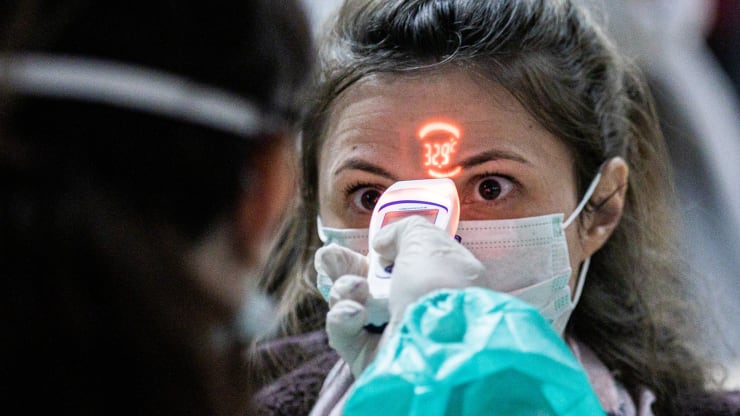The stock markets responded to the world’s unease over the spread of the coronavirus known as COVID-19 with a drop of 1,000 points on Monday, Feb. 24, followed by another 900 point drop Tuesday. The virus has spread to 37 countries, with disturbing new pockets in Iran and in northern Italy; which it is reported, has the highest incidents of cases outside China.
Tuesday morning, Feb. 25, the tone taken by U.S.health officials talking with lawmakers and reporters in Washington changed. The serious warning; that the spread of coronavirus into the U.S. now appears inevitable. This marks a significant change in official statements since the outbreak began in China in December.
“Ultimately, we expect we will see community spread in the United States,” said Nancy Messonnier, a top official at the Centers for Disease Control and Prevention (CDC) in a briefing for reporters following her meeting with congressional leaders this morning. “It’s not a question of if this will happen but when this will happen and how many people in this country will have severe illnesses.”
The world – which for weeks has watched China attempt to stem the spread of the coronavirus – now appears inadequately prepared to handle the global public health threat it represents. Global travel disruptions appear likely. In the European Union in particular, with its open borders, officials are accelerating efforts to contain the virus and screening passengers at airports.

Mardi Gras in Venice has been shut early by the spread of the coronavirus. Photo courtesy of Bloomberg
Italy, which saw a 45 percent jump in cases in a single day, responded by closing off several rural towns north of Milan, and shutting down the famed Venice Mardi Gras earlier than scheduled. Tues. morning South Korea reported nearly 1,000 cases and Iran reporting at least 15 deaths.
Tuesday afternoon Austria, Croatia and Switzerland reported their first cases, most of which health authorities linked to Italy. This evening word has been received that a U.S. soldier stationed in South Korea has tested positive for COVID-19.
Only this morning President Donald Trump finally made a nearly $2.5 billion request to the United States Congress for emergency funding to prepare to handle the public health emergency. But speaking from India earlier today, he minimized the potential impact of the disease, saying that the U.S. has the virus under control.
Against those statements, these facts: On Jan. 12, 202o there were 41 cases of the COVID-19 virus in Wuhan, China, with one death. By Feb. 25 there were 80,000 cases in nearly 40 countries around the world, with more than 2,700 deaths. While a pandemic has not yet been declared, the formal title might not matter.
Some members of Congress were not impressed by the size of the request. Senator Michael Bennet (D-Colo.) issued the following statement: “The Trump Administration’s response to this global crisis has been pitiful. It is clear that the administration lacks a clear and comprehensive strategy to address this challenge and the amount of funding requested is woefully insufficient to the scale of this emergency. To make matters worse, President Trump has left critical positions sitting empty at the very agencies charged with protecting our national security and public health. The Trump Administration must treat this emerging threat with the urgency it demands.”
Asked about the potential for broad economic disruption, economists have taken a concerned stance. “Stocks are due for a bumpy ride as the market assesses the growing likelihood of a broad economic downturn,” said Ball State University economist Michael Hicks, speaking with The Washington Post. “The economic fundamentals of recession in China and the increasing risk of COVID-19 clearly point to more losses. This is not just a few spooked investors.”
While rural mountain communities such as Chaffee County may appear somewhat isolated from global pandemic fears, the fact is that Chaffee County, like the rest of the country, is only one car ride — one plane ride away — from potential spread of the virus. Those with international travel plans in particular will want to pay close attention to the developing situation.
“Obviously, this is a dynamic situation,” said Chaffee County Director of Public Health Andrea Carlstrom. “I think it is important for our locals to know that we are closely monitoring the situation and are in regular communications with CDPHE [Colorado Department of Public Health & Environment] and CDC through multiple e-mail channels. In addition, we are working with our emergency health care partners and emergency management to ensure that our pandemic plans are reviewed and updated and that we have the supplies and resources needed to be prepared.”
One of the issues adding to concern is the news from the CDC that a week and a half ago, it apparently issued government coronavirus test kits with a faulty component. This might limit the U.S. capacity to rapidly increase testing, just as the outbreak has entered a worrisome new phase around the world. While this might not sound serious, it is. You can’t organize a response if you don’t know what you’re facing, or where to marshal your resources.
According to reports in The Washington Post, while South Korea has already run more than 35,000 coronavirus tests, the United States has tested only 426 people for the virus, not including people who returned on evacuation flights, with 14 confirmed cases. There are still only a handful of state laboratories that can run tests outside of the Centers for Disease Control and Prevention in Atlanta.
According to Carlstrom, current U.S. guidelines recommend testing for a very narrow group of people — those who display respiratory symptoms and have recently traveled to China or had close contact with an infected person.
But with the disease now in 37 countries and growing daily, some infectious disease experts believe that the small number of U.S. cases reported so far might have more to do with limited testing here, not the virus’s geographic reach. With the virus spreading locally in countries outside China, no knows whether there may be other people, undetected, mixed in with colds and flu. No one knows whether that’s the case in the U.S., because they aren’t checking.
Carlstrom said her strategy to prepare to handle the coronavirus threat is to participate in all the public health professional conference calls and all the ones for public information officers as well. The Chaffee Public Health group is also monitoring the CDC page regarding high risk countries.
“I’m regularly monitoring all CDC sources regularly. I’m pulling my info from all the department resources, just like we do when we deal with any potential outbreak; whether its flu, norovirus, Hepatitis A, or this coronavirus,” said Carlstrom. “We are looking at our plans – reviewing them for relevancy. We’re making sure we have enough personal protective equipment (PPE) – masks, gloves, gowns – especially for first responders. We will distribute mass PPE as long as supplies are available. There has been a shortage, which is no surprise. But when this first broke we did that inventory right away.”
In addition to continuing to provide direct updates to the media and community, Carlstrom provided three official websites for the public to go to for information:
https://www.cdc.gov/coronavirus/2019-ncov/index.html
https://www.cdc.gov/coronavirus/2019-ncov/travelers/index.html
https://www.colorado.gov/pacific/cdphe/2019-novel-coronavirus
According to Carlstrom, “We don’t have any oversight [in public health] but the CDC knows what they are doing. I know the whole team working on this at the state level. They are all competent subject matter experts and they are communicating with us locally.”
Featured image: Italy is monitoring passengers at airports for symptoms of the coronavirus. Photo by Bloomberg News.







Recent Comments